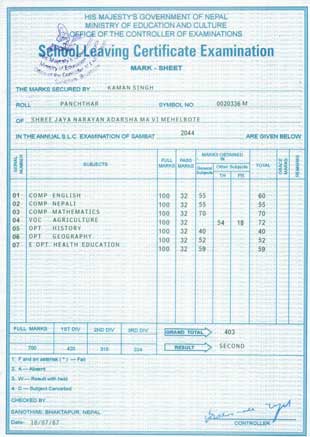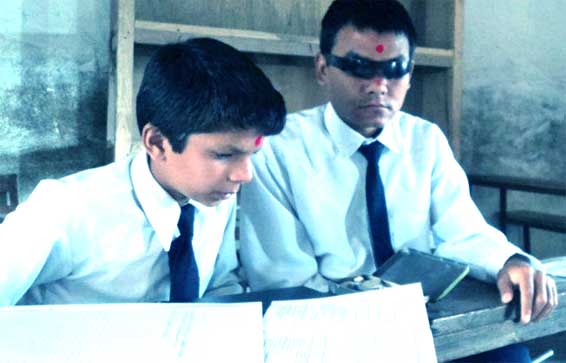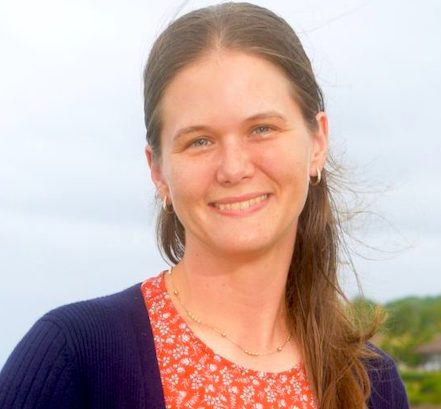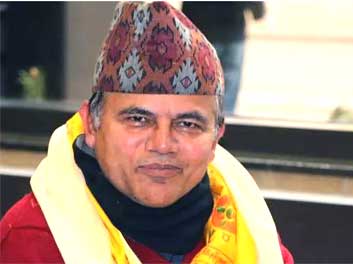[vc_row][vc_column width=”1/1″][vc_column_text]The School Leaving Certificate (shortly known as SLC and known in Nepali as prabeshika parikshha) is a nationally administered and monitored high-school-matriculation examination in Nepal.
Students obtain this qualification after completing a 10-year long secondary schooling system and participating in and passing a series of final board exams. The SLC exam, also known as iron-gate due to its importance and difficulty, is indeed regarded as one of the most important and most difficult examinations in Nepal. The examination is conducted by the Office of the Controller of Examinations, a government agency of Nepal government’s Ministry of Education. As of 2015, the Government of Nepal is planning to scrap the traditional grading system of pass-fail and different divisions and is reported to be taking an initiative to introduce a new grading system that ranks students from A to D, without a failing grade. The SLC is also famous for its high profile board toppers and notorious due to several incidences of suicides committed by unsuccessful students in the aftermath of each year’s result publication.[/vc_column_text][vc_column_text css=”.vc_custom_1432310657259{border-top-width: 9px !important;padding-top: 5px !important;padding-right: 5px !important;padding-bottom: 5px !important;padding-left: 5px !important;background-color: #e8e8e8 !important;border-top-color: #dd3333 !important;border-top-style: solid !important;}”]

| In Nepali | एस एल सी परिक्षा |
| Started in | 1934 |
| Annually taken by | > 0.4 million students |
| Conducting authority | Office Of The Controller Of Examinations, Nepal |
[/vc_column_text][vc_column_text]
History of the SLC Examination in Nepal
The School Leaving Certificate (SLC) examination was first introduced in Nepal in 1934 and the Durbar High School which was operated exclusively to educated the children of the ruling authoritarian Rana dynasty in Nepal became the first school to participate in the SLC exams.
Though Jung Bahadur Rana established the Durbar High School, it was during Shree 3 Ranodipsing’s tenure and out of Dhir Shamsher initiative that the school was expanded up to grade 10.
Though the Rana rulers operating the Durbar High School provided certificates to students that completed grade 10, their certificates were not accredited by foreign educational institutions. Due to this, the Durbar High School had to get an affiliation with an internationally recognized academic institution.
In 1880, after the Durbar High School managed to make a deal with the University of Calcutta in Kolkata, India, the first batch of Nepali students went to appear in SLC-eqivalent entrance exams in the university. The government bore all the expenses of the students’ travel and accommodation and Dhir Shamsher’s second son Khanga Shamsher was one of the examinees to attend the exams. Khanga Shamsher couldn’t pass the exams, but received a medal anyway because he was a student from the Rana family. Dhir Shamsher’s another son, Chandra Shamsher, was the first Nepali to pass the SLC-equivalent entrance exams of the Calcutta University. Some other popular names to pass the exam were Shriniwas Giri, Kedarnarshingh Rana, Balban Singh Pradhan and Asthaman Rajbhandari.
The Durbar High School’s affiliation with the Calcutta University and this form of SLC examination lasted for 44 years till 1917. However, since the number of students were growing each year and logistical as well as financial burdens were increasing, the Nepal government asked the Calcutta University to establish an exam centre in Kathmandu. The university denied the request. As an alternative, a similar request was made to Patna University which accepted the offer to establish an exam centre in Kathmandu and accredited newly established Tri-Chandra College as one of its units.
Though in 1934 the SLC examination, in principle, came under the control of Nepal government’s Department of Education, still the exams activities were run and supervised by the Patna University officials. Eventually starting 1946, Nepal was capable of conducting the SLC exams itself and since then hundreds of thousands of Nepali students have appeared in the SLC exams. With its long history, authority and popularity, the SLC examination system has gone through a tremendous reforms over time.
SLC Exam Format
The SLC is not an standardized test and students need to attend exams for 8 subjects which are of 100 marks each. Passing grade for each subject is 32. Students that secure more than 80% of full mark receive a Distinction grade whereas students that secure minimum 60% to 79% received a First Division label in their mark-sheet.

SLC examinations are organized normally during the first month of Nepali calendar, Baishak, and students normally attend one subject-exam per day and subjects like Science and English also involve practical and oral tests. Traditionally, students were asked questions from their subject books of grade 9 and 10, but after a recent reform, nowadays students answer questions only from Grade 10. SLC examination and result publication both receive nationwide media attention in Nepal.
traditionally published by the government-owened national broadsheet Gorkhapatra, nowadays SLC results are published mainly online after 2-3 months of initial exam dates. In the current system, if students fail up to 2 subjects, they are allowed to attend quickly organized supplementary exams, which are also known an compartment exams. If they have failed more than two exams, they have to retake entire exams the following year. However, they are exempted from taking a school test or sent-up exam. That is why these students are also called exempted students.
SLC Exam Subjects
The SLC exam subjects traditionally used to be of 700 full-marks, however, after a reshuffle in the system, the new arrangement is of 800 full marks and 8 subjects. The subjects involve compulsory as well as elective ones. A list of SLC subjects is given below:
1. Compulsory Subjects
- Compulsory Mathematics
- Compulsory English
- Compulsory Science
- Compulsory Nepali
- Social Studies
- Health, Population and Environment Education
- Optional Mathematics (Known as Opt math)
- Optional Economics
- Optional Geography
- Optional History
- Optional Population
- Optional Environment Science
- Optional English
- Optional Office Management and Account
- Optional Education
- Computer Science
- Optional Health and Physical Education
- Optional Agriculture
- Optional Home Science
Controversies and Criticisms
The SLC examination system has been criticized by educationists in Nepal for many years for a number reasons. First, since the exam is very hard and diverse, many Nepali students do not pass it. SLC completion rates specially in government-funded public schools and among rural parts of Nepal has been consistently low. There are cases of suicides or suicide attempts after each annual SLC result is published.
The SLC exam is also criticized for the unhealthy competition it has created in Nepal’s education sector. After every SLC result is published, students that receive exceptionally high scores are allured by big private colleges in Nepal and they are virtually ‘bought’ to work as marketing material for them. The system of declaring board topper caused similar unhealthy competitions and the government has banned the practice since 2005 after 79 years.
A 2014 study conducted by Yogendra Bahadur Bhattarai for Candan’s Carleton University identifies four categories of negative consequences of the SLC exam results 1. long lasting chronic consequences 2. short- and long-term psychological consequences 3. career related consequences; and, 4) extreme negative consequences.
Bhattarai’s study recommends that these negative consequences can be addressed by including practical and vocational education for unsuccessful students, making families and school environments student-friendly and responsible and also by introducing alternatives to the SLC exam.
See Also
External Links
[/vc_column_text][/vc_column][/vc_row]



Comment: how we know the actual grade when average grade only is available in markhsheet.nd below which grade student will attend supplimentary exam.
Pingback: Prerana Adhikari - WikiGlobal | the celebrity encyclopedia